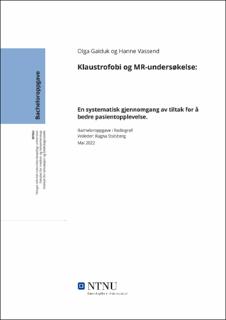| dc.contributor.advisor | Stalsberg, Ragna | |
| dc.contributor.author | Gaiduk, Olga | |
| dc.contributor.author | Vassend, Hanne | |
| dc.date.accessioned | 2022-07-12T17:21:14Z | |
| dc.date.available | 2022-07-12T17:21:14Z | |
| dc.date.issued | 2022 | |
| dc.identifier | no.ntnu:inspera:110850715:111763974 | |
| dc.identifier.uri | https://hdl.handle.net/11250/3004877 | |
| dc.description.abstract | SAMMENDRAG
Hensikt: MR-radiografer møter daglig pasienter som opplever klaustrofobi, og har derfor stor nytte av å ha kunnskap om ulike metoder og strategier for håndtering av angstpregede pasienter. Hensikten med denne studien er å gi en systematisk oversikt over hvilke tiltak og metoder som kan benyttes for å bedre opplevelsen av en MR-undersøkelse for klaustrofobiske pasienter. Studien er med på å skape bevissthet omkring de aktuelle tiltakene, forståelse overfor pasientenes opplevelser og radiografenes evne til å håndtere situasjonen.
Metode:I denne systematiske litteraturstudien er analysert både kvalitativ og kvantitativ forskning. Det var totalt tretten studier som møtte kriteriene for inklusjon og eksklusjon.
Resultat: Analyse resulterte i fem hovedkategorier innenfor angstdempende metoder: kommunikasjon, informasjon, musikk, hypnose og andre mindre tiltak. Kommunikasjon mellom radiograf og pasient både fysisk og over intercom anses som den viktigste. God samhandling, tilstedeværelse og bevissthet omkring ordvalg er også avgjørende for en klaustrofobisk pasients opplevelse av MR-undersøkelsen. Tilrettelagt, enkel og samtidig detaljert informasjon om undersøkelsen gir en trygghet hos pasienten og øker sjansen for å fullføre undersøkelsen. Mange pasienter liker å høre på musikk under undersøkelsen og føler seg mer avslappet, men musikk er ikke avgjørende for å mestre undersøkelsen. Hypnose kan fungere godt for noen pasienter, men anses som et ressurskrevende og dermed mindre passende tiltak for å redusere klaustrofobi på MR.
Konklusjon: Alle pasienter er forskjellige og har ulik opplevelse av MR-undersøkelse, og trenger derfor tilpasset tiltak etter behov. Det er derfor viktig at radiografer ha oversikt over metoder og tiltak, som kan benyttes når situasjoner omkring klaustrofobiske pasienter oppstår. Kommunikasjon, samhandling med pasienten og tilpasset informasjon er anerkjent som de viktigste tiltakene for å håndtere pasienter med klaustrofobi. | |
| dc.description.abstract | ABSTRACT
Purpose: MRI radiographers meet patients with claustrophobia on a daily basis, and therefore would benefit greatly from having knowledge of different methods and strategies for dealing with anxious patients. The purpose of this study is to provide a systematic overview of measures and methods that can be used to improve the experience of an MRI examination for claustrophobic patients. The study helps to create awareness around the relevant measures, understanding patients' experiences and the radiographers' ability to handle the situation.
Method: In this systematic literature study both qualitative and quantitative research have been analyzed. A total of thirteen studies which met the criteria for inclusion and exclusion were found.
Result: Analysis resulted in five main categories within anxiety-reducing methods: communication, information, music, hypnosis and other minor measures. Communication between radiographer and patient both physically and via intercom is considered as the most important. Good interaction, presence and awareness of word choice are also crucial for a claustrophobic patient's experience of the MRI examination. Adapted, simple and at the same time detailed information about the examination provides security for the patient and increases the chance of completing the examination. Many patients like to listen to music during the examination and feel more relaxed, but music is not essential for mastering the exam. Hypnosis may work well for some patients, but is considered a resource-intensive and thus less appropriate measure to reduce claustrophobia on MRI.
Conclusion: All patients are different and have different experiences of MRI examination, and therefore need adapted measures as needed. It is therefore important that radiographers have an overview of methods and measures, which can be used when situations around claustrophobic patients arise. Communication, interaction with the patient and customized information are recognized as the most important measures for dealing with patients with claustrophobia. | |
| dc.language | nob | |
| dc.publisher | NTNU | |
| dc.title | Klaustrofobi og MR-undersøkelse:
En systematisk gjennomgang av tiltak for å bedre pasientopplevelse. | |
| dc.type | Bachelor thesis | |
